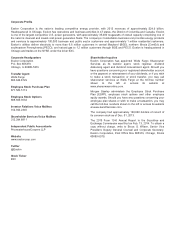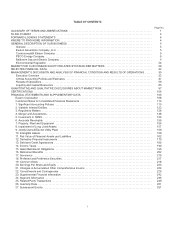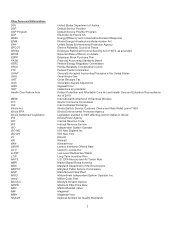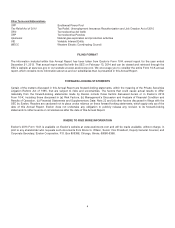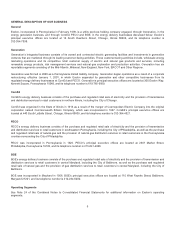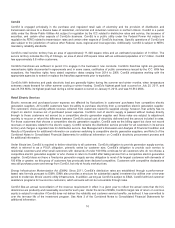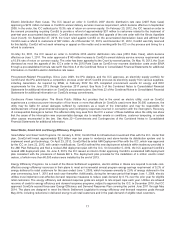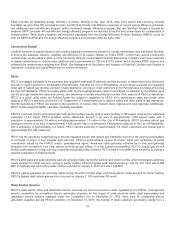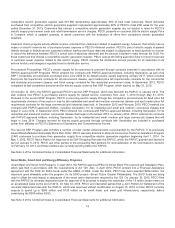ComEd 2013 Annual Report Download - page 15
Download and view the complete annual report
Please find page 15 of the 2013 ComEd annual report below. You can navigate through the pages in the report by either clicking on the pages listed below, or by using the keyword search tool below to find specific information within the annual report.Generation will execute an IndemnityAgreement pursuant to which Generation will indemnify EDF anditsaffiliatesagainstthird
partyclaims that mayarisefromanyfuture nuclear incident (asdefinedinthePriceAnderson Act)inconnection withtheCENG
nuclear plantsor their operations. Exelon will guarantee Generation’s obligationsunder this indemnity.
CENG owns100%offour nuclear unitsinMarylandandNewYorkand82%ofNine Mile Point Unit2inNewYork. Generation
currentlyhasan agreement under which itis purchasing 85% ofthenuclear plant output owned by CENG that is not soldto third
partiesunder pre-existingfirmandunitcontingent PPAsthrough 2014. Beginningon January1,2015andcontinuingto theendof
thelifeoftherespective plants, Generation will purchaseonaunitcontingent basis 50.01%ofthenuclear plant output ownedby
CENG, and EDF will purchaseonaunitcontingent basis 49.99% ofthenuclear plant output owned by CENG (EDF PPA). This
agreement will continue to beeffectiveandisnot affectedbytheMaster Agreement,except that if the put option under theMaster
Agreement is exercised, then theEDF PPAwouldtransfer to Generation upon thecompletion ofthePut Option Agreement
transaction.
Currently, Exelon andGeneration account for itsinvestment inCENG under theequitymethodofaccounting. The transfer ofthe
operational control to Exelon andGeneration will result inExelon andGeneration beingrequiredto consolidate thefinancial position
andresultsofoperationsof CENG. When that accountingchangeoccurs, Exelon andGeneration will derecognizeitsequitymethod
investment inCENG andwill recordall assets, liabilitiesandthe non-controllinginterestinCENG at fairvalue on Exelon and
Generation’s balancesheets. Any differencebetween theformer carryingvalue andnewlyrecordedfairvalue at that date will be
recognizedasagainorloss upon consolidation, which couldbematerial to Exelon’s andGeneration’s resultsofoperations. See
Note 5—Investment inCENG oftheCombinedNotesto ConsolidatedFinancial Statementsfor additional information regarding
CENG.
Nuclear Operations. Capacityfactors, which are significantlyaffectedbythenumber andduration ofrefuelingandnon-refueling
outages, can haveasignificant impactonGeneration’s resultsofoperations. Asthe largestgenerator ofnuclear power intheUnited
States, Generation can negotiate favorable terms for thematerialsandservicesthat itsbusiness requires. Generation’s operations
fromitsnuclear plantshavehistoricallyhadminimal environmental impactandthe plantshaveasafe operating history.
During2013 and2012,thenuclear generatingfacilitiesoperatedbyGeneration achievedcapacityfactorsof 94.1%and92.7%,
respectively. Generation managesits scheduledrefuelingoutagesto minimizetheirduration andto maintainhigh nuclear generating
capacityfactors, resultinginastable generation basefor Generation’s wholesale andretailmarketingandtradingactivities. During
scheduledrefuelingoutages, Generation performs maintenanceandequipment upgradesinorder to minimizetheoccurrenceof
unplannedoutagesandto maintainsafe,reliable operations.
Inaddition to therigorousmaintenanceandequipment upgradesperformedbyGeneration during scheduledrefuelingoutages,
Generation hasextensive operatingandsecurityproceduresin placetoensure thesafe operation ofthenuclear units. Generation
hasextensivesafety systems in place to protectthe plant,personnel andsurroundingarea inthe unlikelyevent ofan accident.
Regulation of Nuclear Power Generation. Generation is subjecttothejurisdiction oftheNRCwithrespecttothe operation ofits
nuclear generatingstations, includingthelicensingfor operation ofeach unit.TheNRCsubjectsnuclear generatingstationsto
continuingreviewandregulation covering, amongother things, operations, maintenance,emergency planning, securityand
environmental andradiological aspectsofthosestations. Aspart ofitsreactor oversight process, theNRCcontinuouslyassesses
unit performanceindicatorsandinspection results, andcommunicatesitsassessment on a semi-annual basis. AsofDecember 31,
2013,theNRCcategorizedDresden units2and3,LaSalle unit2,andClinton intheRegulatoryResponseColumn, which is the
second highestof five performancebands. All other unitsoperatedbyGeneration are categorizedintheLicensee ResponseColumn
asofDecember 31,2013, which is thehighest performanceband. OnJanuary1,2014, Dresden units2and3 returnedto the
Licensee ResponseColumn.TheNRCmaymodify, suspendor revoke operatinglicensesandimposecivil penaltiesfor failure to
complywiththe Atomic Energy Act,theregulationsunder such Actorthe terms ofthe operatinglicenses. Changesinregulationsby
theNRCmayrequire a substantial increaseincapital expendituresfor nuclear generatingfacilitiesand/or increasedoperatingcosts
ofnuclear generatingunits.
OnMarch 11,2011,Japan experienceda9.0magnitude earthquakeandensuingtsunami that seriouslydamagedthenuclear units
at theFukushimaDaiichi Nuclear Power Station, which are operatedbyTokyoElectric Power Co.InJuly2011,an NRCTask Force
formedintheaftermathoftheFukushimaDaiichi events issueda report ofitsreviewoftheaccident,includingrecommendationsfor
future regulatoryaction by theNRCto betaken inthe near andlonger term. TheTask Force’s report concludedthat nuclear reactors
intheUnitedStatesare operatingsafelyanddo not present an imminent risk to public healthandsafety. TheNRCanditsstaff have
issuedordersandimplementation guidancefor commercial reactor licenseesoperatingintheUnitedStates. TheNRCanditsstaff
9


